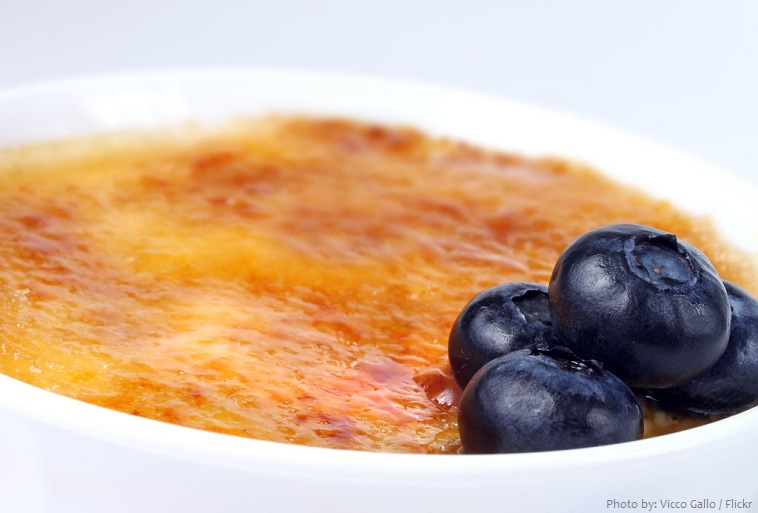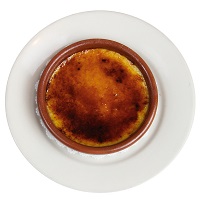Crème brûlée meaning “burnt cream,” is a dessert.
It consists of a rich custard base made of heavy cream, egg yolks, sugar and vanilla is topped with a texturally contrasting layer of hardened caramelized sugar.
The custard base is traditionally flavored with vanilla, but can have a variety of other flavorings including chocolate, orange liqueur and fruit.
The custard is sprinkled with sugar that is caramelized under a broiler or with a kitchen blowtorch.
This dessert is normally served slightly chilled; the heat from the caramelizing process tends to warm the custard producing a cool center.
The caramelized sugar crust can be covered with a liqueur and set on fire.
The exact origin of crème brûlée is uncertain. France, England, and Spain all claim to be the country where crème brûlée had its origin.
The first printed recipe for a dessert called crème brûlée is from the 1691 edition of the French cookbook Le Cuisinier Royal et Bourgeois by Francois Massialot, a cook at the Palace of Versailles. That version was a sweet custard of egg yolks and milk with a burnt sugar crust. It is similar to the modern versions.
At Trinity College, Cambridge, England, the dessert was known as ‘burnt cream’. The college crest was burnt into sugar on top of a custard using a hot iron. It may predate Massialot’s cookbook with one authority claiming it was first served at Trinity in 1630.
Catalans claim their dessert known as crema catalana is the original. It is a rich custard often flavoured with cinnamon and lemon or orange zest topped with carmelized sugar. The Catalan version was first recorded in the 18th century. It is also called Crema de Sant Josep, after Saint Joseph, the husband of the Virgin Mary. In Spain and in many other parts of Europe, Saint Joseph’s Day is celebrated on 19 March. Crema Catalana is a traditional dessert served on this day.
There are records of Thomas Jefferson serving a similar dessert at the White House 1 and even the 1942 edition of The Boston Cooking School Cookbook by Fannie Merritt Farmer includes a recipe.
Crème brûlée was not very common in French and English cookbooks of the nineteenth and twentieth centuries. It became extremely popular in the 1980s, “a symbol of that decade’s self-indulgence and the darling of the restaurant boom”, probably popularized by Sirio Maccioni at his New York restaurant Le Cirque. He claimed to have made it “the most famous and by far the most popular dessert in restaurants from Paris to Peoria.”
The largest crème brulee weighed 725.72 kg (1,599.96 lb) and was made by students of the Le Cordon Bleu Program at the Orlando Culinary Academy, Orlando, Florida, USA on 12 February 2005. K Hopkins adjudicated.
July 27th is national crème brûlée day.




